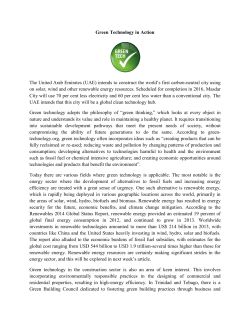
Experiences in developing municipal scale energy management
UK Cities Energy Systems Round Table Policy Workshop Event Lessons Learned from Developing Municipal Scale Energy Management Systems March 24, 2015 Presented by: David J. Anderson Executive Vice President Energizing a Sustainable World Presentation Overview • • There are contrasting market conditions and policy drivers supporting large scale Municipal energy project development in the U.S. compared to the U.K. Municipal renewable energy development is active in U.S. states with Renewable Portfolio Standards or other requirements providing for incentives such as Renewable Energy Credit (RECs) and Net-Metering – Supports project financing – Requires utilities to purchase renewable energy – Allows for municipalities to enter into alternative arrangements, such as PPAs • Municipal energy efficiency development is driven by budget constraints, deferred maintenance, policies and programs – Some states provide technical assistance to municipalities – Cities are striving to lead by example through sustainability and to streamline operations or privatize certain facilities – Privately-delivered energy efficiency through ESPC serves municipal sector 2 Policy Overview United States United Kingdom Federal legislation deals only with U.S. Government agencies use of energy efficiency and renewable energy—does not regulate state, municipal, or utility programs for RE or EE. Energy Saving Opportunity Scheme (ESOS) is a mandatory energy assessment for large organisations in the UK that meet the qualification criteria; energy audit by Dec 2015. The UK Government drives energy efficiency through energy market price mechanisms and by creating emission markets where large users must purchase emission licenses for CO2. 29 states have mandatory renewable electricity portfolio standards—which require utilities to purchase renewable energy and establishes incentives such as Renewable Energy Credits (RECs) or net-metering. This has encouraged PPAs for large RE, and net-metering has encouraged residential and non-residential PV. Energy Act, 2013, stimulates market reform and incents investment in low carbon electricity generation and ensuring security of supply. Energy Act requires Energy Performance Certificates with at least E rating to lawfully rent select properties post April 2018. Initiated roll-out of smart meters for residential and small business. 20 states have energy efficiency resource standards—which drives energy efficiency investments primarily through ratepayer programs. The U.S. does not have national building codes developed through a national process and adopted uniformly nationwide. Instead, there are recognized organizations that develop codes and standards that are adopted by state or local (municipal or county) governments. 2011 Building Regulations that enforce greater efficiency requirements for the new and existing non-domestic buildings. Includes procedural regulations that set out what kind of work needs approval, approval should be obtained, and technical standards. The “Merton Rule” requires that a new commercial building of more than 100m2 must gain at least 10 of its energy from on site renewable sources to receive planning consent. Federal legislation does provide tax incentives for the production and investment of renewable energy and also for energy efficiency in commercial and public buildings. The capital cost of certain energy efficiency devises qualifies for one year accelerated write down against corporation tax. In 2014, the U.S. Environmental Protection Agency (EPA) released the Clean Power Plan, a proposal aimed to cut carbon pollution from the existing U.S. power sector by 30 percent by 2030 compared to 2005 levels. The plan sets state by state specific goals to achieve by 2030, and the majority of states will be required to reduce their CO2 emissions by at least 30% compared to a 2012 baseline. There are approximately 1,000 fossil fuel fired-power plants with 3,000 units covered by this plan and states can utilize various approaches to reducing their associated emissions output. Climate Change Act established a framework to develop an economically credible emissions reduction path. It also strengthened the UK’s leadership internationally by highlighting the role it would take in contributing to urgent collective action to tackle climate change under the Kyoto Protocol. CRC Energy Efficiency Scheme (formerly Carbon Reduction Commitment) is mandatory emissions reduction scheme applying to large non-energyintensive organisations in the public and private sectors. It has been estimated that it will reduce emissions by 1.2 million tonnes of carbon per year by 2020. 3 Financial Incentives and Structures Supporting U.S. Project Development • Federal, State and Local – – – – • Tax Incentives for Renewable Energy and Energy Efficiency Bonds, Grants and Subsidies Utility Rebates RECs, SRECs and Net-Metering Energy Procurement Programs – Municipal Aggregations – State, Local Programs • PACE • Utility Programs • Private-Financing – ESPC • No upfront costs, budget-neutral pay thru savings – PPA • Utilizing RECs where applicable and tax incentives 4 State Case Study: Massachusetts • • Massachusetts' RPS was one of the first programs in the nation requiring a percentage of the state's electricity to come from renewable energy. The Alternative Energy Portfolio Standard (APS) was established to complement the RPS Program.1 State government leads by example setting energy requirements for public buildings and fleets, benchmarking energy use, and encouraging the use of ESPCs.2 – – – – – Executive Order 484 (2007) requires a reduction in overall energy consumption in state-owned and leased buildings (at which the state pays directly for energy) by 20% by fiscal year 2012 and 35% by 2020 (based on a fiscal year 2004 baseline). Green Communities Act (2008) mandates new buildings owned or operated by the state must minimize life-cycle costs by using energy efficiency and renewable energy. MA’s Green Communities Division developed and MassEnergyInsight, a free, web-based tool that helps cities and towns make informed, targeted decisions about energy efficiency investments. It provides communities with customized electricity, natural gas, and oil usage information to allow local officials to understand where there is energy waste and act to reduce it. Massachusetts is a partner in the US DOE Better Buildings Challenge, a voluntary program which sets long range energy reduction targets for a select buildings. Requires tracking and reporting. Accelerated Energy Program, a joint initiative of the DOER and Division of Capital Asset Management and Maintenance, is targeting a 25% reduction in energy, greenhouse gas emissions and energy costs at 58 million square feet of state buildings. Source: (1) http://www.mass.gov/eea/energy-utilities-clean-tech/renewable-energy/rps-aps/ ; (2) http://database.aceee.org/state/Massachusetts: (3) http://www.mass.gov/eea/grants-and-techassistance/guidance-technical-assistance/agencies-and-divisions/doer/ 5 For the fourth straight year, Massachusetts has been named number one by the American Council for an Energy Efficient Economy.3 State Case Study: Massachusetts • U.S. leader in state renewable energy and efficiency programs – One of first to establish RPS in the U.S. – Ranked #1 in energy efficiency by ACEEE • State participates in the Regional Greenhouse Gas Initiative (RGGI) a 9 state regional cap and trade program – First market-based regulatory program in the United States to reduce greenhouse gas emissions from the power sector – MA uses proceeds towards energy efficiency investments in the state • State government leads by example setting energy requirements for public buildings and fleets, benchmarking energy use, and encouraging the use of ESPCs Source: (1) http://www.mass.gov/eea/energy-utilities-clean-tech/renewable-energy/rps-aps/ ; (2) http://database.aceee.org/state/Massachusetts: (3) http://www.mass.gov/eea/grants-and-techassistance/guidance-technical-assistance/agencies-and-divisions/doer/ 6 For the fourth straight year, Massachusetts has been named number one by the American Council for an Energy Efficient Economy.3 State Case Study: Massachusetts • Massachusetts Green Communities4 – Provides technical assistance and financial support for municipal initiatives to improve energy efficiency and increase the use of renewable energy in public buildings, facilities and schools – As of Dec 2014, there were 136 designated green communities • MA offers a variety of grant, rebate, and bond programs to encourage EE and RE – Plus, Net-Metering and RECs support municipal PPAs for renewable energy • MA also has net-metering caps for public and private sectors – Encourages PV in municipal sector Source: (4) http://www.mass.gov/eea/docs/doer/green-communities/grant-program/map-summarygreen-communities.pdf 7 Project Case Study: City of Lowell, MA • • Energy savings performance contract – energy efficiency – Municipal and school facilities: nearly 3 million sq. ft., across 47 buildings – Public housing authority: 1,638 apartment units across 10 sites – Capital investment: £19.5 million ($30 million) – Energy conservation measures: lighting retrofit and controls, energy management systems, water conservation, insulation/weather proofing, boiler plant decentralizations, replacement HVAC equipment – Term: 20 years – Utility rebates: £781,320 ($1.2 million) – Guaranteed energy savings: £1.6 million ($2.5 million) annually Power purchase agreement – solar PV – Phase 1: 341.9 kW – 5 rooftop-mounted systems – Phase 2: 1.5 MW – ground-mounted on capped landfill – Capital investment: £0 ($0) (Ameresco designed, built, owns and maintains) – Utility rebates: £781,320 ($1.2 million) – Guaranteed energy savings: 1.8 million kWh annually 8 Thank you Local Contacts: Tony Coleman or Dipak Shah Ameresco 60 Buckingham Palace Road London, SW1W 0AH, UK +44 20 3542 8300 Derek Dixon or Kath Chapman Ameresco Wesley House, 5 Wesley Street Castleford WF10 1JGW, UK 0871 230 1824 Case studies can be seen at: www.ameresco.com/page/videolibrary Energizing a Sustainable World
© Copyright 2025









